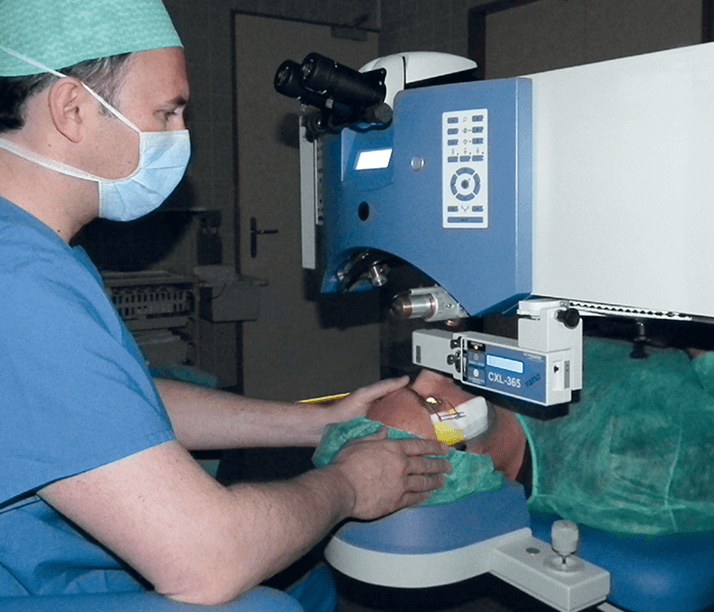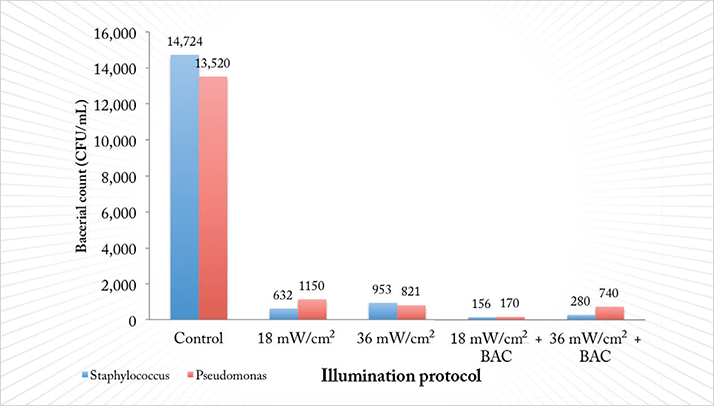
Currently, corneal cross-linking (CXL) with riboflavin and UV-A light is used to perform two key roles. The first is strengthening the cornea, which helps to slow or halt corneal ectatic disorders. The second is the treatment of infectious keratitis, in a process called PACK-CXL (photoactivated chromophore for keratitis–CXL). But both applications use the same illumination protocol that was originally designed for the first application (1): 3 mW/cm² total energy UV-A illumination for 30 minutes.
In the field of photochemistry, there’s the Bunsen–Roscoe law of reciprocity, which states that the overall photochemical effect of a reaction should remain the same when the same total energy (fluence) is used. This should mean that doubling the illumination power, halves the illumination time required for a given effect. But this doesn’t hold true when cross-linking corneal collagen: the biomechanical effect of CXL seems to significantly decrease when high irradiance/short irradiation time settings are used. The reason for this is oxygen: Farhad Hafezi’s research group in Switzerland showed in 2013 that oxygen is a critical component of the corneal cross-linking reaction, and that it can’t diffuse across the stroma fast enough under high fluence conditions, resulting in suboptimal cross-linking (2). But does this limitation also apply to PACK-CXL? Seemingly not. Recent work by Hafezi’s group (3) has suggested that Bunsen-Roscoe applies to PACK-CXL. The team applied 10 µL of bacterial suspension (containing either Pseudomonas aeruginosa or Staphylococcus aureus) to 10 mm-diameter pig corneal lamellae discs of defined thickness, then PACK-CXL was applied at one of two accelerated irradiation settings: 5 minutes at 18 mW/cm², or 2.5 minutes at 36 mW/cm², both yielding a fluence of 5.4 J/cm², with or without benzalkonium chloride in the 0.5% riboflavin solution. The lamellae and bacterial suspension were then incubated at 37°C under aerobic conditions for an hour, plated the cells, then the number of colony forming units were counted.

What they found was irrespective of the irradiation settings, PACK-CXL eradicated most of the bacterial colonies (Figure 1). With S. aureus, the killing rates were 92.5 percent for the 5 min illumination, and 94.4 percent, for 2.5 min. It was a similar story with P. aeruginosa; killing rates were 93.2 and 92.9 percent respectively – and the presence of benzalkonium chloride made no significant difference to the killing rates in any setting. These killing rates are similar to the ones obtained when using the original settings of 30 min at 3 mW/cm². Why does Bunsen-Roscoe hold for PACK-CXL, but not for CXL for ectasia? The study’s authors hypothesize that “the killing rate of PACK-CXL depends on the oxidative stress induced by the photoactivated chromophore. The more reactive oxygen species that are created within a short period of time, the more oxidative damage is imposed to the DNA of the pathogens” (3).
References
- G. Wollensak, E. Spoerl, T. Seiler, “Riboflavin/ultraviolet-a-induced collagen crosslinking for the treatment of keratoconus”, Am. J. Ophthalmol., 135, 620–627 (2003). Hammer, O. Richoz, A. Mosquera, et al., “Corneal biomechanical properties at different corneal cross-linking (CXL) irradiances”, Invest. Ophthalmol. Vis. Sci,. 55, 2881-2884 (2014). doi: 10.1167/iovs.13-13748. O. Richoz, S. Kling, F. Hoogewoud, et al., “Antibacterial efficacy of accelerated photoactivated chromophore for keratitis-corneal collagen cross-linking (PACK-CXL)”, J. Refract. Surg., 30, 850–854 (2014). doi: 10.3928/1081597X-20141118-01.
